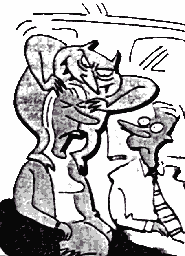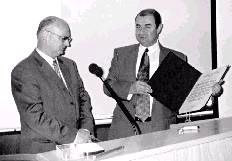Tudományos program |
Tudományos és Technológiai Magyar-Amerikai Tét Közös Alapítvány keretein belül május 29. és június 3. között látogatást tettünk New York állambeli Syracuse Suny Upstate Orvosegyetemén. Ottlétünkkel a 2 évvel ezelőtti budapesti együttlétet viszonoztuk. Az eltöltött idő során alkalmunk volt az egyetem osztályainak megtekintésére, beleláthattunk működésébe. Egynapos közös, tudományos program keretein belül ismerhettük meg egymás tevékenységét.
Bevezetésként dr. Romics Imre professzor átnyújtotta Prof. dr. Haas Gábornak az Urológiai Tanszék vezetőjének megelőzőekben a Semmelweis Egyetem által odaítélt Honoris Causa Oklevelet. Első előadásként dr. Romics Imre professzor a magyar urológia történetéről tartott összefoglalást, amely kiegészült nemzetünk egyéb tevékenységéről és történetéről szóló áttekintéssel. Ezt követte dr. Nádas György a vesetumorok diagnosztikájáról szóló összefoglalója. |
A képen Prof. dr. Haas Gábor (jobbról) és Prof. dr. Romics Imre |
Szünet után felkért amerikai előadók következtek a New York-i Memorial Sloan-Kettering intézetből: Prof. dr. Peter Scardino, az Egyetem Urológiai Rákcentrumának igazgatója foglalta össze lokalizált a prosztatarák prognosztikai modelljét és kezelés eredményeit. Ezután dr. Michael Zelefsky az Onkológiai Radiológiai Osztály brachyterápiás részlegének vezetője tartott előadást a prosztatarák brachyterápiás módszereiről.
Szünetet követően ismét klinikánkról következtek felkért előadások: Prof. dr. Romics Imre 204 vesetumor miatt műtött beteg követéséről számolt be, dr. Lovász Sándor a vesetumorok műtéteinél használt behatolások előnyeit és hátrányait elemezte, dr. Böszörményi-Nagy Géza a veserák lymphadenectomiák szerepéről adott áttekintést. Az utolsó és egyben záró előadást dr. Szűcs Miklós tartotta a vesetumorok immun-kemoterápiájáról.
A közös ebédet követően műtéti bemutatón vettünk részt, ahol a prosztatarák brachyterápiáját seed implantáció módszerét láthattuk. Arról, hogy ez a látogatás nemcsak hasznos, hanem baráti hangulatú is volt, Prof. dr. Haas Gábor professzor gondoskodott, mindent felülmúló vendégszeretettel. Folytatás jövőre a Semmelweis Egyetem, ÁOK Urológiai Klinikáján.
Dr. Szűcs Miklós
Meghívó |
“Cerebrovaszkuláris Fórum” a Klinikai Kísérleti Kutató és Humán Élettani Intézetben
David W. Busija
a Wake Forest University
Élettani és Farmakológiai Intézetének professzora
“Effects of ischemia on cerebral arteries and tissues” címmel tart előadást október 4-én 16 órakor az intézet könyvtárában (Üllői út 78/A).
Információ: dr. Kollai Márk
PÁLYÁZATI FELHÍVÁS |
Az Európai Unió 5. Kutatási és Technológiafejlesztés Keretprogramjának fontos részét képezi a humán kutatói erőforrás és a társadalmi-gazdasági tudásbázis fejlesztése.
A kulcsakció 3 területre oszlik:
- kutatási témák
- az összehasonlító szociológiai és humán kutatások infrastruktúrájának fejlesztése
- szociológia kutatások fejlesztése
Az 5. keretprogramban ezen a területen ez az utolsó pályázati felhívás, amelynek benyújtási határideje 2002. január 15.
A pályázattal kapcsolatos kérdésekben Rudan Ferenc szakfőtanácsos szívesen ad tájékoztatást az érdeklődőknek (473– 7279, ferenc.rudan@om.gov.hu).
A “Quality of life" program is új pályázati felhíváscsomagot jelentetett meg. Részletei megtalálható az alábbi internetcímen: http://www.cordis.lu/life
Fontos, hogy a pályázati felhívásokat minél több érdeklődő megismerhesse!
Dr. Préda István
A LANCET-BEN OLVASTUK |
LIFELINE
Peter Csermely
 | Peter Csermely is the Professor of Biochemistry at Semmelweis University, Budapest, Hungary, Chief Scientist of Biorex Co, Hungary, and the Secretary of Cell Stress Society International. His research is on stress proteins. He has set up an initiative to provide research opportunities for 3500 gifted high school students annually. He has published three books and many research papers (a total citation of more than 1000). |
– Who were your most influential teachers, and why?
– My high school students, who always give me the best questions on science.
– Which research event has had most effect on your work, and why?
– When my mentor, Ron Kahn warned me that some dirt on my autoradiography was actually a discovery.
– What would be your advice to a newly qualified doctor?
– Always observe the whole person and never forget: a smile can be more efficient than a medicine.
– What is the best piece of advice you have received, and from whom?
– Medawar taught me that everyone can be good in science: only endurance, high standards, playfulness, and a tight control of fluttering thoughts are important.
– What are you favourite books, and why?
– The diaries of my late father, and my mother’s poems: it is never too late to learn who am I.
– What is you favourite country?
– Hungary – everything is possible.
– What is your greatest regret?
– I am still not able to control a western lifestyle whit eastern philosophy.
– What do you think is the most exciting field of science at the moment?
– None alone, but any of them synthesised with others.
– What is your greatest fear?
– That science becomes even more fragmented and competitive: young students are lost in information and do not even recognise the need for a more general view.
– What part of your work gives you the most pleasure?
– Whenever I have a new scientific idea, I feel a happiness of an unprecedented intensity, a touch of God.
Jabs & Jibes
Me and T’iu |
Migraine during transatlantic flights poses many challengers. Access to the toilet becomes crucial. The associated inflight vomiting is a truly miserable experience. Use of sickness-bags needs skill, and is not willingly undertaken in public. Other passengers get upset by the migraineur’s haggard appearence, groaning, and retching. Disclosure is problematic. Will other people understand or be sympathetic? The best hope is a knowledgeable flight attendant; he or she can only offer towels and aspirin, but such action legitimises the “illness”. Otherwise, the migraineur might be regarded as drunk; I was once admonished (while weak and ketotic) to stay off the liquor!
 | Migraine regularly pre-empts our plans. With dark humour and self-mockery, we describe suddenly being reduced to a blind, groaning harpy during important events. We don’t talk much about the exhausted “mornings after” or our resentment about days stolen from our lives. We negotiate with migraine. Situations of high expectation or responsibility are irresistible to the condition. I dread weekend call; inevitably, sleep disruptions precipitate symptoms by Saturday, Sunday is a struggle to make good clinical decisions, and Monday is invariably unproductive. Migraineurs are cautious about big events, even inviting a migraine “early” to clear important days. Migraine knows these tricks and mocks attempts to gain control. |
The ancient Sumerians had a migraine demon named T’iu. T’iu’s invocation has splendid language: “headache flashing like lightening in the desert, it cleaveth like a straw he who respecteth not he gods”. My image of T’iu is a mocking gargoyle clamped on the victim’s neck or shoulder, talons driven through the migraineur’s eye. Patients might describe migraine as a dark presence, not always active. For one of my patients, migraine is a beautiful but terrible serpent coiled inside her temple – when it stirts, she perceives its power and iridescent scales. If she is respectful, the attack does not develop, but once aroused, the serpent seizes the orbit and thrashes the head with muscular contractions. This may all be highly Freudian, but migraineurs can relate!
We migraineurs also relate to an ancient description: “these patients fear the light and wish to die” (from 150 AD). Although the depths of a migraine are not spiritual, we have prayed, negotiated, and at times expected to die during an attack. Even stoical St Paul saw migraine as a lesson in humility. St Hildegard (when not making her reputation as a mystic from her migraine hallucinations) believed that migraine affected only one side of the head because nobody could possibly survive such pain bilaterally.
The migraineur’s perspective on life is conditioned by distressing, recurrent, unpredictable symptoms. For some, migraine is a nuisance, whereas others use it to manipulate people and situations. We object to being branded as “migraine types”, especially if psychological labels are attached to an already nasty physical process. After a lot of professional and personal experience, I have negotiated my current balance, but expect to change treatments as the migraine evolves and I age. I was born with a biochemical vulnerability and expect to live with it, including on my regular transatlantic flights. So, if between London and Dallas you see a small lady in dark glasses who looks progressively more distressed and haggard, please be nice, ignore the noises, give her the aisle seat, ask for oxygen, and clear the route to the toilet. She has to spend the flight in the clutches of T’iu – unless you have some crocodile dung for the exorcism in your hand luggage!
Anne Walling
(2001 July)
A demencia diagnosztizálása az első lépés Szeptember 21. Alzheimer Világnap |
Az Alzheimer Világnapot első alkalommal szervezték meg Magyarországon.
Világszerte jelenleg 18 millió ember szenved különféle demenciában, de hazánkban is már 200 ezerre tehető a diagnosztizált betegek száma. Ahogy a világ népessége öregszik, és növekszik a demenciával diagnosztizált emberek száma, egyre többen fordulnak segítségért az Alzheimer Társaságokhoz. Ezek feladatuknak tekintik, hogy támogatást nyújtsanak a demenciával, elsősorban az Alzheimer-kórral élőknek és családtagjaiknak.
Nehéz megmondani, hogy pontosan mikor is kezdődik el a demencia folyamata, és minden bizonnyal sokféle, igazán súlyos betegség is állhat az egyszerű, szinte mindennapos viselkedés, a feledékenység mögött. Ezért a figyelmet arra kívánják ráirányítani a szakemberek, hogy ha az emberek ideggyógyászati, pszichiátriai tüneteket észlelnek rokonaik és ismerőseik normálisnak vagy mindennaposnak tartott feledékenysége mellett, ha netán hirtelen jelentkezik a feledékenység, vagy annak jelentős súlyosbodása észlelhető, mindenféleképpen a családorvoshoz kell fordulni. Mint ismeretes, egy időben elkezdett kezelés, rehabilitáció, agytorna és a helyes gyógyszeres terápia lehetővé teszi, hogy időskorban is megfelelő minőségű életet éljenek a demens betegek.
t–
 2001/10. szám - 2001. szeptember 28. |

